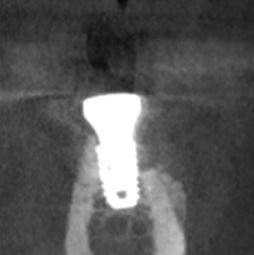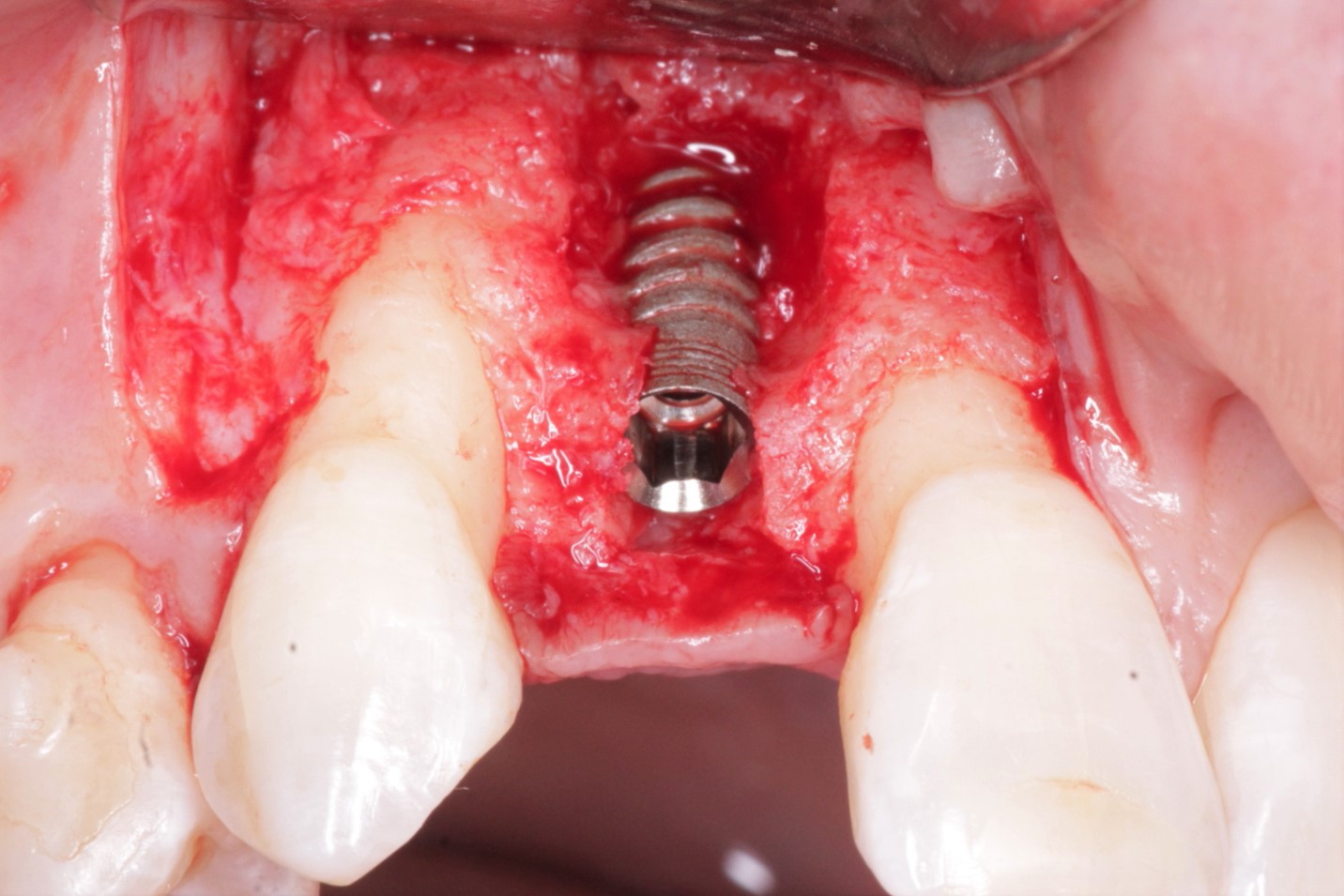Preforated the Lingual Cortical Plate: Should I Proceed with the Overdenture?
Dr. D. asks:
I am a periodontist. I recently placed 4 implants in the mandibular anterior region. While drilling the osteotomy in the premolar-canine area, I inadvertently perforated the lingual cortical plate. I realized my error when I placed the implant which a CBVT scan showed to have perforated the lingual cortical plate by 2mm. The mandible is severely resorbed. After 6 months post-op, the area has healed well without swelling or sign of inflammation or infection. I had treatment planned the patient for an implant retained overdenture. Should I proceed with the overdenture?
15 Comments on Preforated the Lingual Cortical Plate: Should I Proceed with the Overdenture?
New comments are currently closed for this post.
Periodontist
4/25/2011
The biggest risk of perforating the lingual plate is severing a blood vessel which could potentially lead to a compromise of the airway. It has been six months however. If this was a problem you would
have seen it a long time ago. If your cbct is negative for pathology I would inform the patient, document well, an proceed with the restoration. Monitor the patient every six
months.
Ashwath Gowda
4/26/2011
"The biggest risk of perforating the lingual plate is severing a blood vessel which could potentially lead to a compromise of the airway".
Which one or two of the blood vessels quoted above, in the anterior lingualof mandible are at risk of being severed?
Periodontist
4/26/2011
I refer you to an article by Mardinger et al titled "lingual perimandibular vessels associated with life threatening bleeding, an anatomical study. IJOMI 2007 Jan-Feb, 22(1):127-31.
sag
4/26/2011
If you had injured one of the lingual vessels, you would have known it immediately by blood rapidly exiting the implant osteotomy and/or the floor of the mouth rapidly expanding. Obviously that did not happen. It is a non-issue in your case.
You have perforated the lingual plate by 2 mm. Don't worry about it if your implant is stable and reverse torque testing is negative for rotation or pain.
If the perforation is bothering you aesthetically, you can make a limited lingual flap and graft the site with your choice of slowly or non-resorbing graft material.
Carlos Boudet, DDS
4/26/2011
I have perforated the lingual cortical plate placing implants for an overdenture also.
I realized this during my surgery and was able to reangulate the implant and correct the placement.
Your finger on the lingual should allow you to feel a perforation during drilling.
We were both lucky to avoid the aforementioned complications.
I realize your question involves the planned restoration.
If after six months the patient is comfortable and there is no soreness or inflamation, I would inform the restoring dentist andattempt the restoration.
Good luck!
Dennis Flanagan
4/26/2011
There are no arteries of consequence that can be injured by a lingual cortical perforation in the anterior mandible except the sublingual which is severed intra-osseously near the midline. The bone holds this artery like a vise so an osteotomy will indeed cut the artery. The cut artery then retracts into the floor of the mouth and forms a large hematoma. The bleeding can be significant because of anastomoses with the submental, incisive and the contralateral mates. This hemorrhage is not life threatening (as is with a submental bleed in the submandibular space), it is above the mylohyoid and genioglossus muscles.
TBooth
4/27/2011
The lingual artery is intraosseous but it can enter at the midline or have 2 branches which enter in the canine regions!
Bleeding can be life threatening as it can spread into the tissue spaces in the floor of teh mouth and causes teh the tongue to rise and can need a tracheostomy to maintain teh airway!
osurg
4/27/2011
Dr. Flanagan your information is wrong I was involved in two cases were implants were being placed by others and the the anterior lingual plate was perforated. The bleeding which followed caused a psudo ludwig's effect with acute airway obstruction. The patients in both cases required emergency surgical management for the airway.In both of these cases the patient would not have survived without a tracheotomy. Thankfully, I have only seen this twice in over thirty years. As stated the effects were immediate I would worry about a perforation 6 mo. later.
osurg
4/27/2011
sorry that should be not worry six mo. later
Francisco
4/27/2011
The problem is not bleeding after six month. The problem is: as a DDs do you feel clinical confortable with an implant outside the bone ( even partially)?
First inform the patient, second follow the patient, third don ´t believe in miracles.
Robert J. Miller
4/27/2011
The only potential problem at this stage of healing is a serous inflammation within the tissue envelope. The roughened apex will rub on highly mobile tissue until there is an inflammatory reaction and infiltration of monocytes. If the inflammation is profound, you can get additional bone loss on the lingual side. On a CBCT scan, if the apex is only slighty protruding (either on the lingual or inferior border), we have not seen this type of reaction as it tends to have a thick band of connective tissue that forms around it. If a greater part of the body extends into the tissue matrix, you have a much higher probability of this type of reaction. You now have two choices: remove the implant or do an apical resection, both of which can be extremely difficult.
RJM
Pankaj Narkhede, DDS; MDS
4/27/2011
You had no complications during surgery - no worries. If there is no problem after 6 months you will probably never will. Remember staple implants. Or yo must have seen successful cases in articles that has implants placed perforating the lower border of the ridge if there is no sufficient height. Inform patient.
AbG
4/27/2011
nothing to worry right now.. keep the patient under observation and if required implantoplasty at the apical region followed by graft and membrane. However surgical access to this region should be critically considered since the risk of bleeding from lingual vessel is always there if it is injured. Hence it is better to just wait and watch and not create a potential problem in a case which is asmptomatic.All the best
Pieter Boshoff
4/28/2011
Take note of all the anatomy that the previous correspondents have mentioned. Also dont forget the value of sustained finger pressure applied directly to the site of the perforation until help arrives.
I would ,after 6 uneventful months,inform the patient,keep following up,keep notes and hold thumbs.
To attempt surgical planing of the protruding implant-apex will cause more damage than anything else--the perforation was on the lingual aspect and therefore should not be palpable for the patient (as would be the case if it was on the inferior border of the mandible) I commend you on your honesty and courage to share your experience. Many of us would probably have kept quiet. PB
Dr. Dan
5/3/2011
I would think you are probably safe unless there is no stability of the implant or there is pain on palpation or anything else. Sometimes with a slight perforation of the cortical plate, the implant does not necessarily extend past the periostium. If that's so, not the end of the world. If, however, you perforate the soft tissue during placement, take it out and start again at another angle.

















